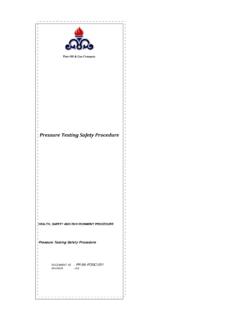Transcription of Gas Sweetening Processes - POGC
1 "OIL AND GAS PROCESSING PLANT DESIGN 2002. AND OPERATION TRAINING COURSE". Page 1. DGEP/SCR/ED/ECP "GAS Sweetening Processes ". "GAS Sweetening Processes ". Excerpt from PRODEM. "OIL AND GAS PROCESSING PLANT DESIGN 2002. AND OPERATION TRAINING COURSE". Page 2. DGEP/SCR/ED/ECP "GAS Sweetening Processes ". 1. GENERAL 4. 2. GAS Sweetening Processes 4. chemical absorption 4. Physical Absorption 25. Physico-Chemical Absorption 28. Physical Adsorption 31. Cryogenic Fractionation 32. Permeation (Membrane) 33. Direct conversion to sulfur 38. Polishing treatment for H2S Removal 38. Guideline for the gas Sweetening process selection 40.
2 3. BIBLIOGRAPHY 41. APPENDIX. Figure Chemical formulas of alknolamines Figure Alkanolamine general Process Flow Diagram Figure MEA Sweetening Process Flow Diagram Figure MEA Reclaimer scheme Figure Boiling point - Condensation versus composition for Aqueous MEA. solutions at bar g. Figure Fluor Econamine Process (DGA) Flow Diagram of BAB gas plant Figure DGA Reclaimer Unit Scheme Figure NGL2 ADIP Unit for Utility Gas Sweetening of UMM SAID. Figure EAP Activated MDEA Process Flow Diagram Figure UOP Amine Guard (UCARSOL Solvent) Process Flow Diagram Excerpt from PRODEM. "OIL AND GAS PROCESSING PLANT DESIGN 2002.
3 AND OPERATION TRAINING COURSE". Page 3. DGEP/SCR/ED/ECP "GAS Sweetening Processes ". Figure MDEA regeneration Process Flow scheme Figure BENFIELD Simplified Base Process Flow Diagram Figure SHELL SULFINOL Simplified Process Flow Diagram Figure RYAN/HOLMES simplified Process Flow Diagram Figure Typical CH4/CO2 Distillation Profiles Figure CO2/ETHANE vapor- liquid equilibrium Figure Cryogenic bulk CO2 Removal Simplified Process Flow Diagram Figure Spiral Wound membrane element Figure Hollow Fiber membrane element Figure One Stage Membrane System Block Diagram Figure Two Stage Membrane System Block Diagram Figure PEREZ COMPANC Membrane Plant Simplified Process Flow Diagram Figure KVAERNER
4 Hollow Fiber Membrane System plant Simplified Process Flow Diagram Figure CYNARA Hollow Fiber Membrane System plant Process Flow Diagram Figure Sweetening Processes for gas containing CO2 only (no H2S). Figure Sweetening Processes for gas containing CO2 and H2S. Figure H2S selective absorption from gas containing H2S and CO2. Table ) Physical properties of pure alkanolamines (ethanolamines). Table ) Advantages and disadvantages between different amines Excerpt from PRODEM. "OIL AND GAS PROCESSING PLANT DESIGN 2002. AND OPERATION TRAINING COURSE". Page 4. DGEP/SCR/ED/ECP "GAS Sweetening Processes ". 1. GENERAL.
5 Natural Gas (from a natural reservoir or associated to a crude production) can contain acid gas (H2S and/or CO2). The Gas Sweetening Process aims to remove part or all of the acid gas that the natural gas contains for different reasons as follows: For safety reason, to remove the H2S content of the natural gas stream. To satisfy a Sales Gas specification : H2S content of the Sales Gas must be below 4 ppm V (about mg of H2S/Sm3 of gas or grains of H2S/100 SCF of gas). CO2 content must be adjusted to allow the Sales Gas to fit with the required range of gross calorific value (GCV). To allow a downstream process to work properly.
6 This is the case for a cryogenic process (the CO2 can freeze at temperatures around -70 ). To decrease the H2S content of a gas used in a crude cold stripping. For Enhance Oil Recovery (EOR) by CO2 injection (CO2 is removed from the gas and injected the oil reservoir). 2. GAS Sweetening Processes . The different Gas Sweetening Processes to be applied depend on the quality and quantity of acid gas contaminants to be removed: CO2 when this is the sole contaminant of the gas H2S when this is the sole contaminant of the gas CO2 and H2S simultaneously Selective removal of H2S when both CO2 and H2S are present in the gas The existing Processes are as follows: Chemical Absorption Physical Absorption Physico-chemical Absorption Physical Adsorption Cryogenic Fractionation Permeation (membrane).
7 Direct conversion to sulfur chemical absorption Several chemical solvents are available for gas Sweetening Processes , almost all of them being based on alkanolamine products. They are all used under form of aqueous solutions. Excerpt from PRODEM. "OIL AND GAS PROCESSING PLANT DESIGN 2002. AND OPERATION TRAINING COURSE". Page 5. DGEP/SCR/ED/ECP "GAS Sweetening Processes ". The main alkanolamine products used in the gas Sweetening industry are as follows : Mononethanolamine or MEA. Diglycolamine ( ) or DGA. Diethanolamine or DEA. Diisopropanolamine or DIPA. Methyldiethanolamine or MDEA. As an alternative to alkanolamine products, an alkaline salt is also used : Hot Potassium Carbonate or HPC or Hot Pot Chemical formulas of alkanolamines are shown in figure Main properties of these products are shown in table ).
8 Chemical absorption process is based on a contact between the gas to be treated (feed gas) and an aqueous solution containing one of the above solvents. Acid gas in the feed gas is a weak acid which reacts with the alkanolamine (alkaline product) or alkaline salt (in the case of potassium carbonate) to give bisulfide (with H2S) and bicarbonate (with CO2). The chemical reaction (chemical absorption) takes place in a fractionation column (absorber or contactor) which is equipped with trays or packing. The gas enters the column at the bottom tray (or at the bottom part of the packing). The aqueous solution enters the column at the top tray (or at the top section of the packing).
9 There is a heat of reaction between the solvent and the acid gas during this absorption, which is exothermic. The treated gas exits the unit at a higher temperature than the feed gas. This implies that the treated gas water content will be higher than the feed gas water content. As a consequence should a dehydration of the gas be also required, this unit will be always installed downstream of the Sweetening unit. The alkanolamine salt is then re-transformed into alkaline solution in a regeneration section and the cycle is repeated again. Description of an Amine process This process flow scheme varies little, regardless of the aqueous amine solution used as the Sweetening agent.
10 Slight modifications can appear linked to the type of amine which is selected and to the optimization of the scheme for specific purposes. The general process flow for an amine Sweetening plant is shown in figure The feed gas (sour gas) containing H2S and/or CO2 always must enter the plant through an Inlet Separator (or feed gas knock-out drum) to remove free liquids and/or entrained solids. Excerpt from PRODEM. "OIL AND GAS PROCESSING PLANT DESIGN 2002. AND OPERATION TRAINING COURSE". Page 6. DGEP/SCR/ED/ECP "GAS Sweetening Processes ". Inlet Separator Objective Catch liquid entrainments (water and hydrocarbon condensate and mist) to prevent entries of contaminants in the amine system Characteristics Generally vertical drum equipped with Demister pad to prevent liquid droplets carry-over Alternatives Cartridge filter-separator The gas from this separator enters the bottom of the Absorber and flows upward trough the column in intimate counter-current contact with the aqueous amine solution (lean solution).







